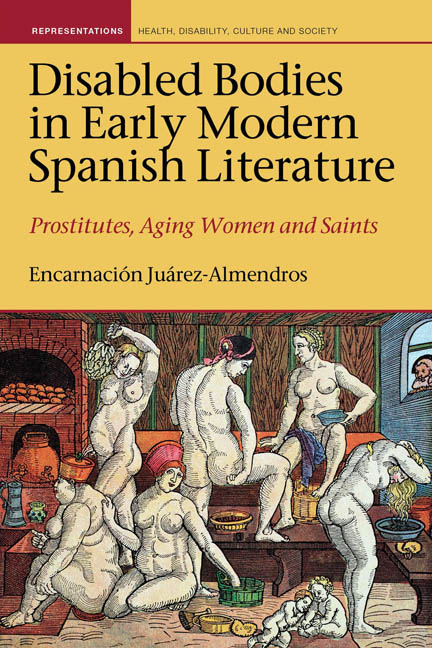Book contents
- Frontmatter
- Contents
- Acknowledgments
- Introduction
- I The Creation of Female Disability: Medical, Prescriptive and Moral Discourses
- II The Artifice of Syphilitic and Damaged Female Bodies in Literature
- III The Disabling of Aging Female Bodies: Midwives, Procuresses, Witches and the Monstrous Mother
- IV Historical Testimony of Female Disability: The Neurological Impairment of Teresa de Ávila
- Conclusion
- Works Cited
- Index
II - The Artifice of Syphilitic and Damaged Female Bodies in Literature
- Frontmatter
- Contents
- Acknowledgments
- Introduction
- I The Creation of Female Disability: Medical, Prescriptive and Moral Discourses
- II The Artifice of Syphilitic and Damaged Female Bodies in Literature
- III The Disabling of Aging Female Bodies: Midwives, Procuresses, Witches and the Monstrous Mother
- IV Historical Testimony of Female Disability: The Neurological Impairment of Teresa de Ávila
- Conclusion
- Works Cited
- Index
Summary
Chapter I provided an overview of various early modern medical texts, public health regulations and moral debates to demonstrate their role in creating and establishing concepts about the inferiority and imperfection of women's bodies in the Iberian Peninsula. Such discourses also informed the social practices and conditions of poor, impaired females, while validating suspicions of any woman who veered from conventional behavior. At every rank of society, from wealthy courtesans to destitute prostitutes, women always fared worse because of their sex. With the spread of syphilis from the late fifteenth century, gendered connotations of the disease became increasingly misogynist as men were portrayed as innocent victims of the women who allegedly contaminated them. The added blame and spectre of contagion further supports the conclusion that in Spanish culture the ostensibly defective female is a master trope for disability in the period.
This chapter examines the literary depiction of the broken and contaminated corporality of female prostitutes as illustrated in Francisco Delicado's La Lozana andaluza [Portrait of Lozana: The Lusty Andalusian Woman] (1528), Miguel de Cervantes's Casamiento engañoso [The Deceitful Marriage] (1613), La tía fingida [The pretended aunt], a novel attributed to Cervantes, and Francisco de Quevedo's satiric poetry written in the first half of the seventeenth century. These works share a common representation of syphilis as a gendered metaphor of physical and moral decay that functions in opposition both to male embodiment and to the ideal of the integrity of the female body, expressed in the concept of virginity and chastity. Furthermore, they exemplify the development of both the syphilitic trope and the diverse solutions to taming alterity through the century. In reading these texts I take into account the complex relationship between creators and their characters, which entails a heteronormative and ableist position of the male authors and their need to transfer patriarchal anxieties to the polluted bodies of women. These writings reveal a flexible understanding of the nature of disease, impairment and creativity according to gender and social status. They also develop issues concerning queerness, gazing, voyeurism, pleasure, fear and apprehension in dealing with difference. The symbolic disabling of female characters is ultimately the result of multiple factors, including literary traditions, concrete ideologies and historical circumstances as well as personal crises affecting the writers.
- Type
- Chapter
- Information
- Disabled Bodies in Early Modern Spanish LiteratureProstitutes, Aging Women and Saints, pp. 56 - 82Publisher: Liverpool University PressPrint publication year: 2017



